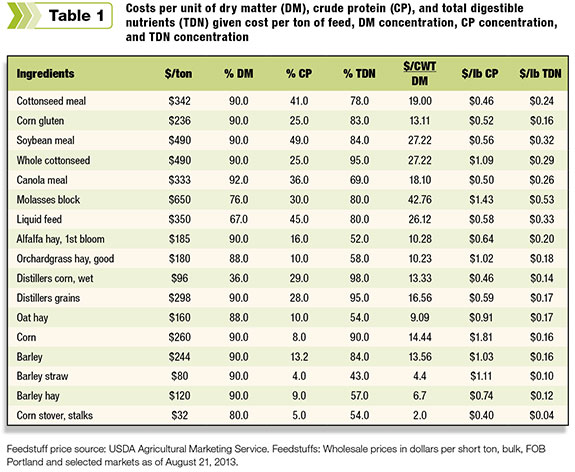Feed is expensive, but you may be surprised by which feeds provide the best value for a given nutrient. Producers should always put the pencil to a ration, but it is critical in times when feed prices are high and feed supply is short. This article describes a process that should be used to determine the value of a feed when you particularly need energy or protein to balance a ration.
The process involves the following steps:
- Take an inventory of your feed on hand.
- Plan rations for each class of animal for each month and determine the amount of each feed needed for the period.
- Allocate your feed on hand to the appropriate class of livestock. Plan to use the best forage resources for the highest need, i.e., young and high-producing animals.
- Determine which supplemental nutrients, for example total digestible nutrients or crude protein, will be needed to economically balance the ration. Test your forages for actual nutrient content to get a better handle on what’s needed.
- Determine the best value for a given nutrient on a dry matter (DM) basis at current prices.
- Consider transportation costs, the risk of feed-induced animal disorders, and cost and practicality of providing the feed. The more water and the less nutrient-dense the feed, the higher the cost per nutrient in the actual delivered cost.
- Consider feed palatability and wastage. For example, barley straw or grass seed straw may be an economical source of fiber and energy, but dry matter intake (DMI) will likely be limited, and wastage could be much higher than buying a good grade of hay.
- Secure the feed sources needed and store them in a manner that minimizes the risk of loss or spoilage.
All nutrients must be compared on a DM basis to determine the lowest cost per nutrient. If the ration needs energy, calculate and compare the costs per unit of total digestible nutrients (TDN) for available feeds at current prices. Then consider the value of other nutrients the feed contains.
We recommend using a decision aid developed at the University of Georgia. The UGA Feed Cost Analyzer is a spreadsheet-based decision aid to compare potential feedstuffs on a price per pound of crude protein (CP) and energy (TDN).
This program consists of a feed library prepopulated with some common feedstuffs, a least-cost feedstuff analyzer and a feedstuffs replacement calculator.
Each page contains step-by-step directions on how to use this decision aid.
Feeds can’t be compared fairly on price per ton alone. The lowest-price feed may not be the most economical feed. Protein and energy are the primary nutrients needed to balance a forage-based ration.
Most natural-source proteins are equally usable by cows, thus price per pound of protein is a good method to determine the best buy.
However, when non-protein nitrogen is the majority of the CP for a product, it is necessary to have a readily fermentable energy source to enable the rumen microbes to take advantage of the non-protein nitrogen.
To compare the price per pound of nutrient between products requires three numbers: the nutrient concentration of the product, the DM concentration and the price per ton.
Example 1
Alfalfa hay at first bloom is available for $185 per ton. The concentration (percentage) of DM is 90 percent, CP is 16 percent and TDN is 52 percent.
First, let us calculate the value of the feed on a DM basis. The cost per ton of feed is divided by 20 to convert the units to hundredweight (cwt), then divided by the DM concentration to express the cost per cwt of DM:

Then calculate the cost per unit of CP on a DM basis by dividing the cost per cwt of DM by the crude protein concentration:

Calculate the cost per unit of TDN on a dry matter basis:

The spreadsheet easily calculates the above values based on the values entered into the feed library tab. Book values are entered into the feed library for convenience, but actual feed test values and current prices should be entered into the feed library for the most accurate analysis.
Compare the cost per pound for the nutrient of interest from the analyzer tab in the spreadsheet. Different ingredients can be selected and compared on this sheet with a pull-down menu that will use data from the feed library sheet.
Table 1 contains some feeds that are available in the West that can be entered into the feed library blank lines.
From the inputs, we can compare costs for each nutrient on a DM basis.
If alfalfa hay is priced at $185 per ton at first-bloom stage, the cost per pound of protein would be $0.64.
If 41 percent cottonseed meal was priced at $342 per ton, then which is most economical?
The protein in cottonseed meal would cost $0.46 per pound, making it the best buy.
However, the cottonseed meal price is freight-on-board at the shipping point and may need to be delivered from Portland, California or Texas, so be sure to consider transportation costs.
Assuming it would cost $90 per ton freight for a semi-load, that price would need to added to the feed cost to provide a cost as delivered: $342 + $90 = $432.
This increases the cost to $0.59 per pound of CP delivered. Each producer will need to research these numbers for the products available to them and consider the value of other constituents, such as TDN.
Example 2
Wet distillers corn is available from a local ethanol plant. Assuming the cost is $96 per ton delivered in a 50-mile radius, the product is 36 percent DM and 29 percent CP, and the cost is $0.46 per pound of CP.
However, this is a high-moisture feed that is expensive and difficult to transport and feed. The shelf life is only about one week, depending on temperature, and it is difficult to feed without blending it into a ration with a vertical mixer.
Example 3
Molasses blocks provide protein for $1.43 per pound of CP, which is more than twice as much as alfalfa hay at $0.64 per pound of CP. How much is the convenience worth for putting out molasses blocks once a week versus alfalfa hay every other day?
Caution
The process described is simple to do but requires common sense and thinking about the entire diet while finding the lowest-cost nutrient.
For example, corn stover (stalk) grazing or feeding barley straw can provide the cheapest source of energy for non-lactating cows up to a point.
However, DMI is restricted because it takes a long time for the fiber to be digested and make room for more intake.
Generally, corn stover, barley straw and grass seed straw are usable up to about half of a dry cow’s ration; then more nutrient-dense feed is needed to balance the protein and energy.
Equally important is the fact that only about half of the protein required for a non-lactating mature beef cow is provided.
Grass seed straw should only be purchased from endophyte-free tall fescue and perennial ryegrass fields. Avoid turf-type grass straws because endophyte-infected straw can kill cows that are not familiar with eating it.
Thus, it is important to use common sense and a ration-balancing program as the next step in formulating a good low-cost ration.
An example of a good ration-balancing program is OSU Cow-Culator from Oklahoma State University, which is designed for beef cows
We highly recommend sampling the feed and getting a feed nutrition test, especially with forages. The nutritional value of forages varies greatly with plant maturity and harvest management.
Forages that have heat damage need a test in addition to CP and TDN because much of the CP is tied up with carbohydrates and is not very digestible.
A test for acid-detergent insoluble CP which shows greater than 1.5 percent can indicate heat damage and the CP level should be discounted.
We recommend using an NFTA-certified forage testing laboratory and TDN determined from the summative equation, not a calculation from acid-detergent fiber.
For more information on sampling forages, see the National Forage Testing Association website.
If you want more assistance with comparing feeds on a nutrient value basis, contact your local extension educator or consulting nutritionist. ![]()
Glenn Shewmaker is an extension forage specialist with the University of Idaho. John Hall and Sarah Baker are also with the University of Idaho.
Extension Forage Specialist
University of Idaho









